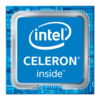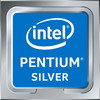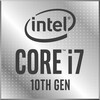Intel Celeron 5305U vs Intel Pentium Silver N6005 vs Intel Core i7-10810U
Intel Celeron 5305U
► remove from comparison
The Intel Celeron 5305U is a low-power dual-core SoC for laptops, based on the Comet Lake architecture, which was introduced in 2020. Compared to Kaby Lake and Whiskey Lake, there are apparently no differences with Comet Lake apart from the two additional cores in the Top model Core i7-10710U. The processor is still manufactured using the mature 14nm process (14nm++ like Whiskey Lake). The processor cores clock at a fixed 2.3 GHz (no Turbo) and also only offer 2 threads (no HyperThreading). Compared to the more powerful Core i3, i5 and i7 variants, the Celeron does not offer SSE (2) support.
You can find more information about the Comet Lake architecture and the available processors on our Comet Lake topic page.
According to Intel, the integrated graphics card is called Intel UHD Graphics, but is an old Intel UHD Graphics 610. It is clocked in the Celeron 5205U at 300 - 900 MHz and is only sufficient for very demanding games. The CPU also offers an integrated DDR4-2666 / LPDDR4x 2933 / LPDDR3-2133 dual-channel memory controller as well as VP9 and H.265 video decoder and encoder.
Performance
The performance of the Celeron 5305U is in the lowest entry-level class of notebook processors in 2020. Due to the lack of Turbo and only 2 cores, the CPU cannot score points in either single-core or multi-core tasks. The processor is therefore only suitable for undemanding tasks such as surfing with a few tabs and office tasks.
The power consumption and performance can be set from 15 to 12.5 watts by the notebook manufacturer via cTDP-down. However, the processor then only runs at 800 MHz and significantly reduced performance. Even at 15 watts, however, the processor is suitable for thin and light notebooks.
Intel Pentium Silver N6005
► remove from comparison
The Intel Pentium Silver N6005 is a quad-core SoC of the Jasper Lake series that is primarily intended for inexpensive and small desktop and was announced in early 2021. The four Tremont CPU cores clock between 2 and 3.3 GHz (single core Burst) and offer no HyperThreading (SMT). The N6005 uses 1.5 MB L2 and 4 MB L3 cache. The chip is manufactured in 10nm at Intel (most likely in the same process as Ice Lake).
CPU Architecture
The processor architecture is called Tremont and a complete redesign compared to the old Golmont Plus cores in the predecessor. According to Intel, the single thread performance of a core could be improved by 30% on average (10 - 80% in all tests of SPECint and SPECfp).
Features
In addition to the quad-core CPU block, the SoC integrates a 32 EU Intel UHD Graphics GPU clocked from 450 - 900 MHz and a LPDDR4(x) dual channel memory controller (up to 16 GB and 2933 MHz). The chip now also partly integrates Wi-Fi 6 (Gig+), 8 PCIe 3.0 lanes, 14 USB 2.0 / 3.2 ports and two SATA 6.0 ports. The package got bigger and measures 35 x 24 mm (compared to 25 x 24 mm for the N5030 e.g.). The SoC is directly soldered to the mainboard (BGA) and can't be easily replaced.
Performance
The average N6005 in our database is in the same league as the Core i3-1110G4, as far as multi-thread benchmark scores are concerned. This is enough to enjoy Web browsing and watch videos online without noticeable slowdowns, as of mid 2023 - which is what most consumers want.
Thanks to its decent cooling solution and a long-term CPU power limit of 15 W, the Intel NUC11ATKPE is among the fastest systems built around the N6005 that we know of. It can be about 50% faster in CPU-bound workloads than the slowest system featuring the same chip in our database, as of August 2023.
Power Consumption
Similar to the predecessor, Intel specifies the TDP with 10 Watts (versus the 6 W of the mobile N6000). The chip can therefore be cooled passively in theory, but SKUs with fans are possible as well.
Intel Core i7-10810U
► remove from comparison
The Intel Core i7-10810U is a power efficient hexa-core SoC for notebooks based on the Comet Lake (CML-U) generation and appeared in March 2020. Compared to the similar Whiskey Lake processors (e.g. Core i5-8665U), the only difference is support for higher memory speeds (DDR4-2666 vs 2400) and two additional cores in the top model. The processor cores are clocked between 1.1 and 4.9 GHz. Thanks to HyperThreading 12 threads can be used. More information on Comet Lake and all the models and articles on it can be found here.
The CPU supports professional management features vPro (as a difference to the i7-10710U).
Thanks to the two additional cores and the high clock rates, the processor performance of the i7-10710U is very good for its class. It should outperform the top Whiskey Lake and also Ice Lake processors if the cooling and TDP settings are not limiting.
The integrated graphics card however is still the same as in the previous generations. It should be still called Intel HD Graphics 620 and clock from 300 - 1150 MHz in the i7. Furthermore, the SoC integrates a VP9 and H.265 de- and encoder and an integrated dual channel DDR4-2666 / LPDDR4x 2933 / LPDDR3-2133 memory controller.
The chip is still produced on the 14nm++ process as Whiskey Lake. The TDP (PL1) is specified at 15 Watts but can be varied from 12.5 to 25 Watt from the manufacturer (cTDP up/down) resulting in different performance (especially Turbo durations). To provide the full performance, Intel proposes a short power peak of 90 W (PL4) for the i7 and therefore 8 W more than the quad-core CML-U CPUs and a whopping 19 W more than Whiskey Lake. Therefore, some slim laptops with 15W CML-U CPUs wont offer the i7 as they cant provide enough power and cooling to get full performance out of the 6 cores.
| Model | Intel Celeron 5305U | Intel Pentium Silver N6005 | Intel Core i7-10810U | ||||||||||||||||||||||||||||||||||||||||||||||||||||||||||||||||||||||||||||||||||||||||||||||||||||||||||||||||
| Codename | Comet Lake-U | Jasper Lake | Comet Lake-U | ||||||||||||||||||||||||||||||||||||||||||||||||||||||||||||||||||||||||||||||||||||||||||||||||||||||||||||||||
| Series | Intel Comet Lake | Intel Jasper Lake | Intel Comet Lake | ||||||||||||||||||||||||||||||||||||||||||||||||||||||||||||||||||||||||||||||||||||||||||||||||||||||||||||||||
| Series: Comet Lake Comet Lake-U |
|
|
| ||||||||||||||||||||||||||||||||||||||||||||||||||||||||||||||||||||||||||||||||||||||||||||||||||||||||||||||||
| Clock | 2300 MHz | 2000 - 3300 MHz | 1100 - 4900 MHz | ||||||||||||||||||||||||||||||||||||||||||||||||||||||||||||||||||||||||||||||||||||||||||||||||||||||||||||||||
| Cores / Threads | 2 / 2 | 4 / 4 | 6 / 12 | ||||||||||||||||||||||||||||||||||||||||||||||||||||||||||||||||||||||||||||||||||||||||||||||||||||||||||||||||
| TDP | 15 Watt | 10 Watt | 15 Watt | ||||||||||||||||||||||||||||||||||||||||||||||||||||||||||||||||||||||||||||||||||||||||||||||||||||||||||||||||
| Technology | 14 nm | 10 nm | 14 nm | ||||||||||||||||||||||||||||||||||||||||||||||||||||||||||||||||||||||||||||||||||||||||||||||||||||||||||||||||
| max. Temp. | 100 °C | 105 °C | 100 °C | ||||||||||||||||||||||||||||||||||||||||||||||||||||||||||||||||||||||||||||||||||||||||||||||||||||||||||||||||
| Socket | BGA1528 | BGA1338 | BGA1528 | ||||||||||||||||||||||||||||||||||||||||||||||||||||||||||||||||||||||||||||||||||||||||||||||||||||||||||||||||
| Features | LPDDR3-2133/DDR4-2400 RAM, PCIe 2, 4 GT/s bus, MMX, SSE, SSE2, SSE3, SSSE3, SSE4.1, SSE4.2, AVX, AVX2, BMI2, ABM, FMA, ADX, VMX, SMEP, SMAP, MPX, EIST, TM1, TM2, SST, AES-NI, RDRAND, RDSEED, SGX | DDR4-2933/LPDDR4x-2933 RAM, PCIe 3, GNA, MMX, SSE, SSE2, SSE3, SSSE3, SSE4.1, SSE4.2, SMEP, SMAP, EIST, TM1, TM2, Turbo, SST, AES-NI, RDRAND, RDSEED, SHA | LPDDR3-2133/DDR4-2666/LPDDR4-2933 RAM, PCIe 3, 4 GT/s bus, vPro, MMX, SSE, SSE2, SSE3, SSSE3, SSE4.1, SSE4.2, AVX, AVX2, BMI2, ABM, FMA, ADX, VMX, SMX, SMEP, SMAP, MPX, EIST, TM1, TM2, HT, Turbo, SST, AES-NI, RDRAND, RDSEED, SGX | ||||||||||||||||||||||||||||||||||||||||||||||||||||||||||||||||||||||||||||||||||||||||||||||||||||||||||||||||
| iGPU | Intel UHD Graphics 610 (300 - 900 MHz) | Intel UHD Graphics (Jasper Lake 32 EU) (450 - 900 MHz) | Intel UHD Graphics 620 (300 - 1150 MHz) | ||||||||||||||||||||||||||||||||||||||||||||||||||||||||||||||||||||||||||||||||||||||||||||||||||||||||||||||||
| Architecture | x86 | x86 | x86 | ||||||||||||||||||||||||||||||||||||||||||||||||||||||||||||||||||||||||||||||||||||||||||||||||||||||||||||||||
| $107 U.S. | |||||||||||||||||||||||||||||||||||||||||||||||||||||||||||||||||||||||||||||||||||||||||||||||||||||||||||||||||||
| Announced | |||||||||||||||||||||||||||||||||||||||||||||||||||||||||||||||||||||||||||||||||||||||||||||||||||||||||||||||||||
| Manufacturer | ark.intel.com | ark.intel.com | ark.intel.com | ||||||||||||||||||||||||||||||||||||||||||||||||||||||||||||||||||||||||||||||||||||||||||||||||||||||||||||||||
| L2 Cache | 1.5 MB | 1 MB | |||||||||||||||||||||||||||||||||||||||||||||||||||||||||||||||||||||||||||||||||||||||||||||||||||||||||||||||||
| L3 Cache | 4 MB | 12 MB | |||||||||||||||||||||||||||||||||||||||||||||||||||||||||||||||||||||||||||||||||||||||||||||||||||||||||||||||||
| L1 Cache | 256 KB |
Benchmarks
Average Benchmarks Intel Celeron 5305U → 100% n=2
Average Benchmarks Intel Pentium Silver N6005 → 135% n=2
Average Benchmarks Intel Core i7-10810U → 394% n=2
* Smaller numbers mean a higher performance
1 This benchmark is not used for the average calculation













